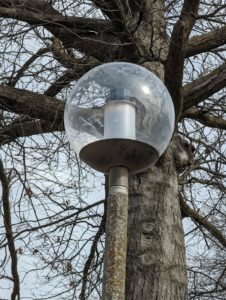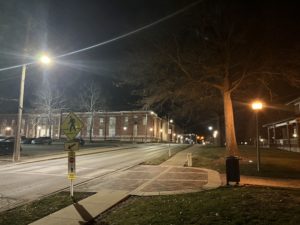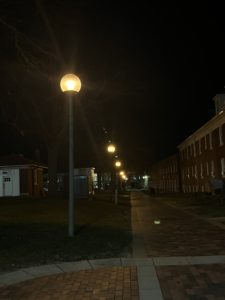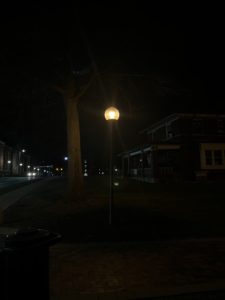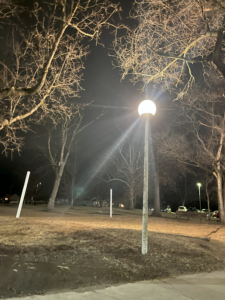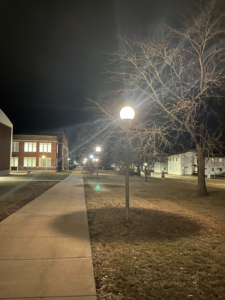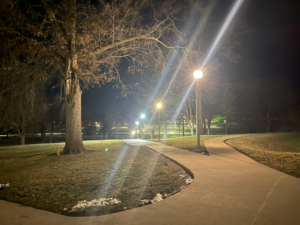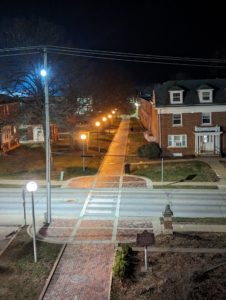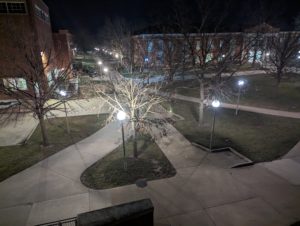Retrofit Amber-colored Lights
Daytime Pictures
Daytime pictures showing the retrofit design. Note the dark top part, which is designed to block light from shooting straight up into the sky. Also note the white “diffuser”, to reduce glare. On the third picture below, you can see the actual LED lights — these are the orange looking circles right below the dark top and at the top end of the diffuser.
Nighttime Pictures
The image below shows the crosswalk on Patterson street, between Magruder Hall (to left of image) and Pershing (right of image). The bright blue-white light is a pole-mounted LED (? Watt, 5000K), supposedly meant to light up the crosswalk. The amber(orange)-colored right to the right of the image is one of the new retrofitted LED lights (35 Watt, 2000K). Note the slightly darker “top” part of the orange light-globe, leading to significant reduction in glare and lack of illumination of the tree branches (above the light) from the orange light.
Additional images of the string of six retrofitted amber colored lights. Again note the relative lack of glare, and the pleasantness of the amber colored light as compared to the harsh, piercing blue-white light.
In the image below, note again the dark “top” part of the light globe on each of these retrofits. This reduces the amount of light from going up into the sky, thus helping mitigate sky-glow. Also note the blue-white glare from the stadium light much father away, as compared to the relative “peasantness” of the amber glow. Measurements indicate that despite consuming significantly less electricity (35 Watts) than previous lights (rated at 50W to 75W), twice as much light reaches the ground with the amber retrofits. Additionally, the variation of light along the lights is significantly smaller (between 1.1 footcandle to 0.45 footcandle) than from existing lights (0.55 fc to 0.07 fc).
Existing Light-Fixtures and Lights
The image below show the existing light fixtures with corn-cob style LED lights which can be purchased off-the-shelf from stores such as Home-depot. These lights work at between 50-75 Watts (or higher), and have colors ranging from off-white and slightly yellowish (CCT = 3000K) to white, blue white color (CCT between 4000K to 5000K). The differences in color are especially evident in the fifth image below. The first two lights on the pathway are about 3000K and have a yellowish glow to them, whilst the next two lights are about 4000K and appear distinctly blue or blue-white in color. Note that for all the lights in these images, the light shine in every direction. In particular, note that the top of these lights are not significantly darker than the rest of the globe. This is evident from the illuminated trees and tree branches in several of the images below.
Uplight
The primary challenge in achieving good lighting on campus is the design of the globe light fixture itself. Replacing these is prohibitively expensive, and thus our current plan is to deploy these retrofits to as many globe light fixtures as possible, and slowly replace some of the globe fixtures with bollard-type lights (for example, as pathway lighting in highly wooded areas like the quad) or better fixtures as the globe fixtures degrade further with age.
Here are some example images of the retrofits and existing globe light fixtures that demonstrate that not only do the retrofits so a better job of directing light towards the ground (and hence we are measuring roughly 1 footcandle on the ground as against about 0.55 fc with existing lights), but the retrofits direct very little light upward. Presently (early 2024) our campus drone is out-of-commission, so we have resorted to taking images of overhanging trees and branches to demonstrate the difference in uplight from the three kinds of globe lights we currently have:
- Naked globe light fixtures (3000K – 5000K, third and fourth images below),
- Globe lights with dark sky reflectors (3000K – 5000K, third and fourth images below) and,
- Globe light fixtures with retrofit lights (2000K, first two images below).
The images above were taken from the Magruder Hall rooftop. The amber colored LEDs in the first two images are a bit farther away, but it is clear that very little, if any, light is going straight up into the sky, since the branches above these lights do not appear to be illuminated at all. In contrast, the third and fourth images show that the amount of uplight from the existing lights in these globe fixtures are significantly illuminating the branches right above and also farther away from the lights.


